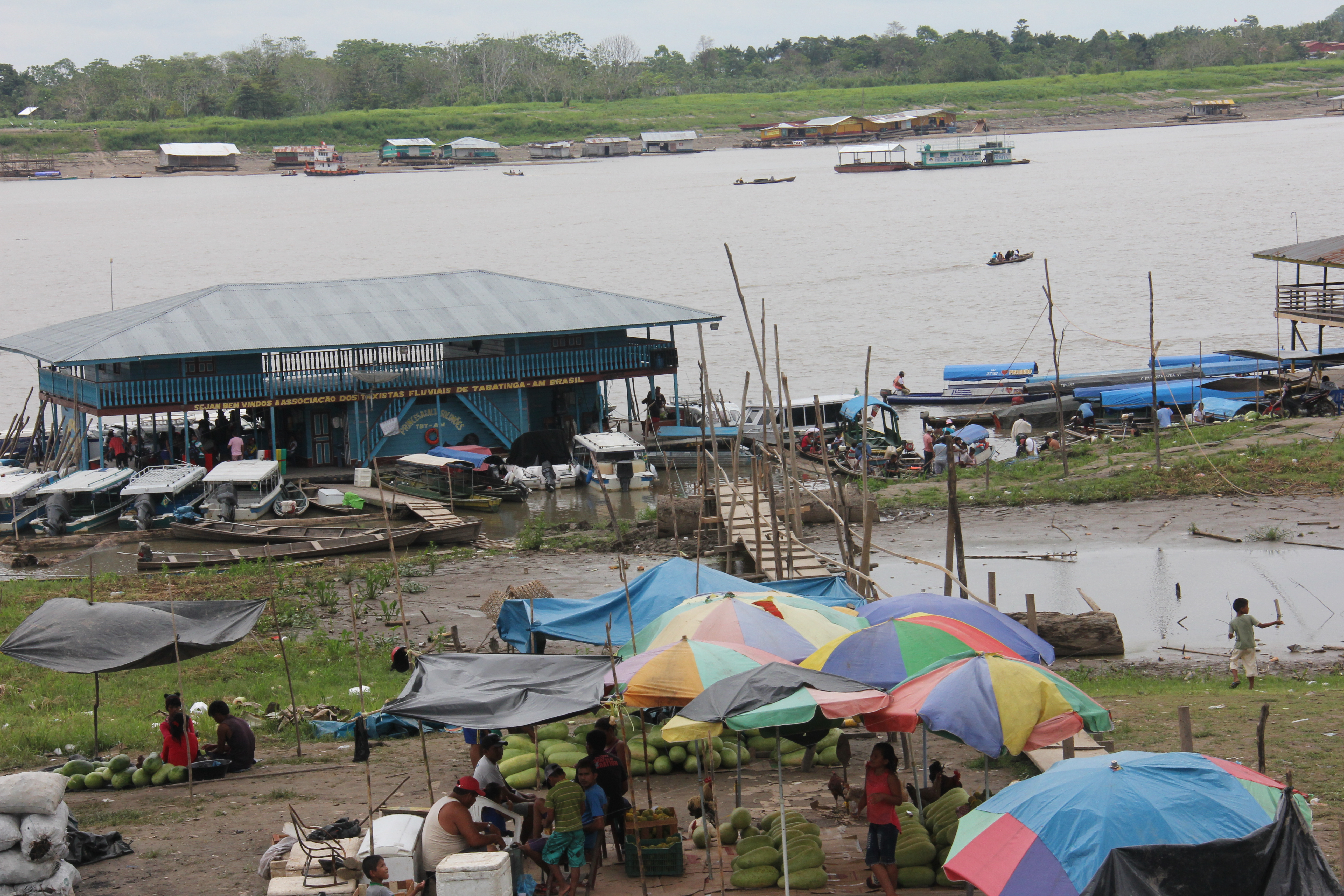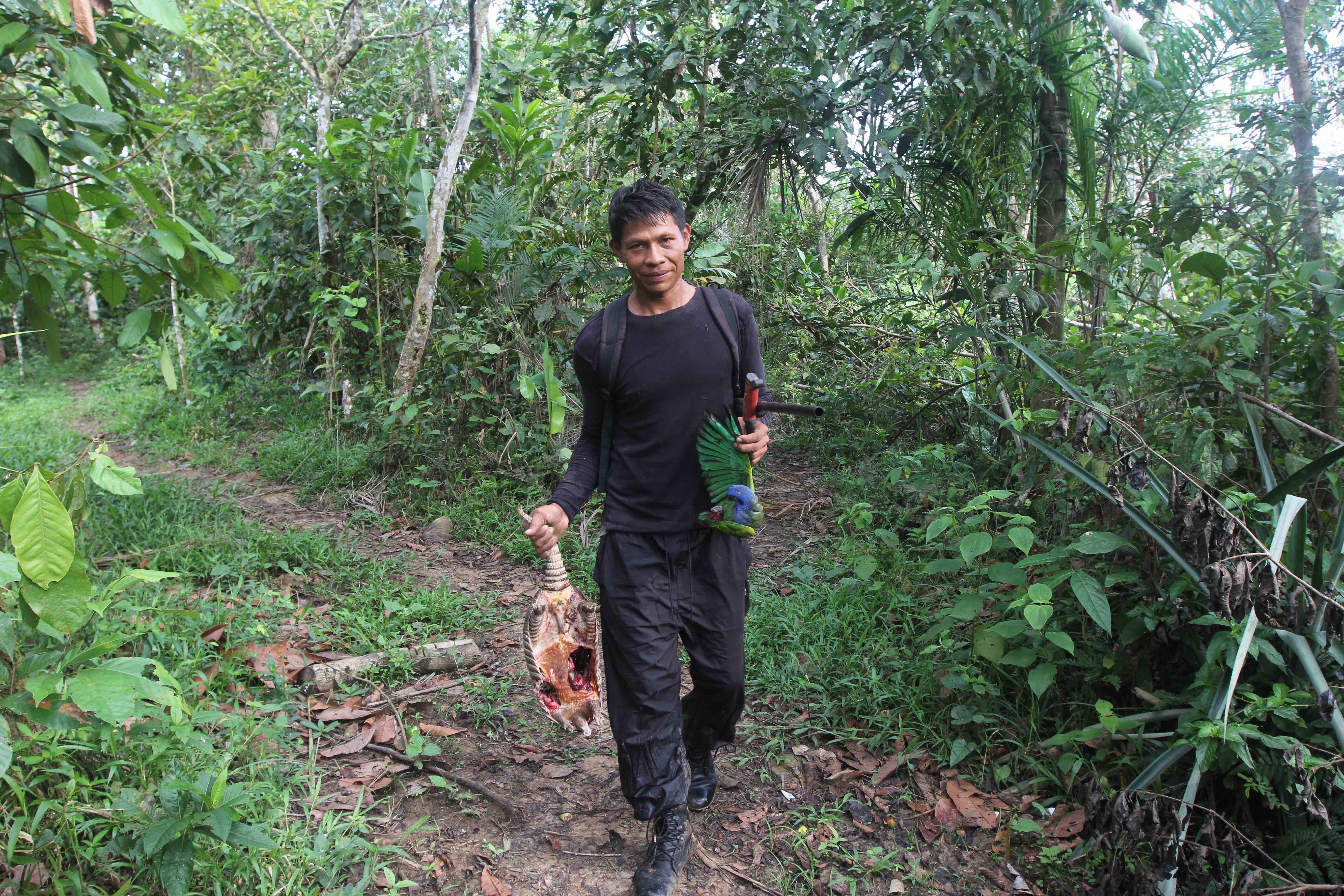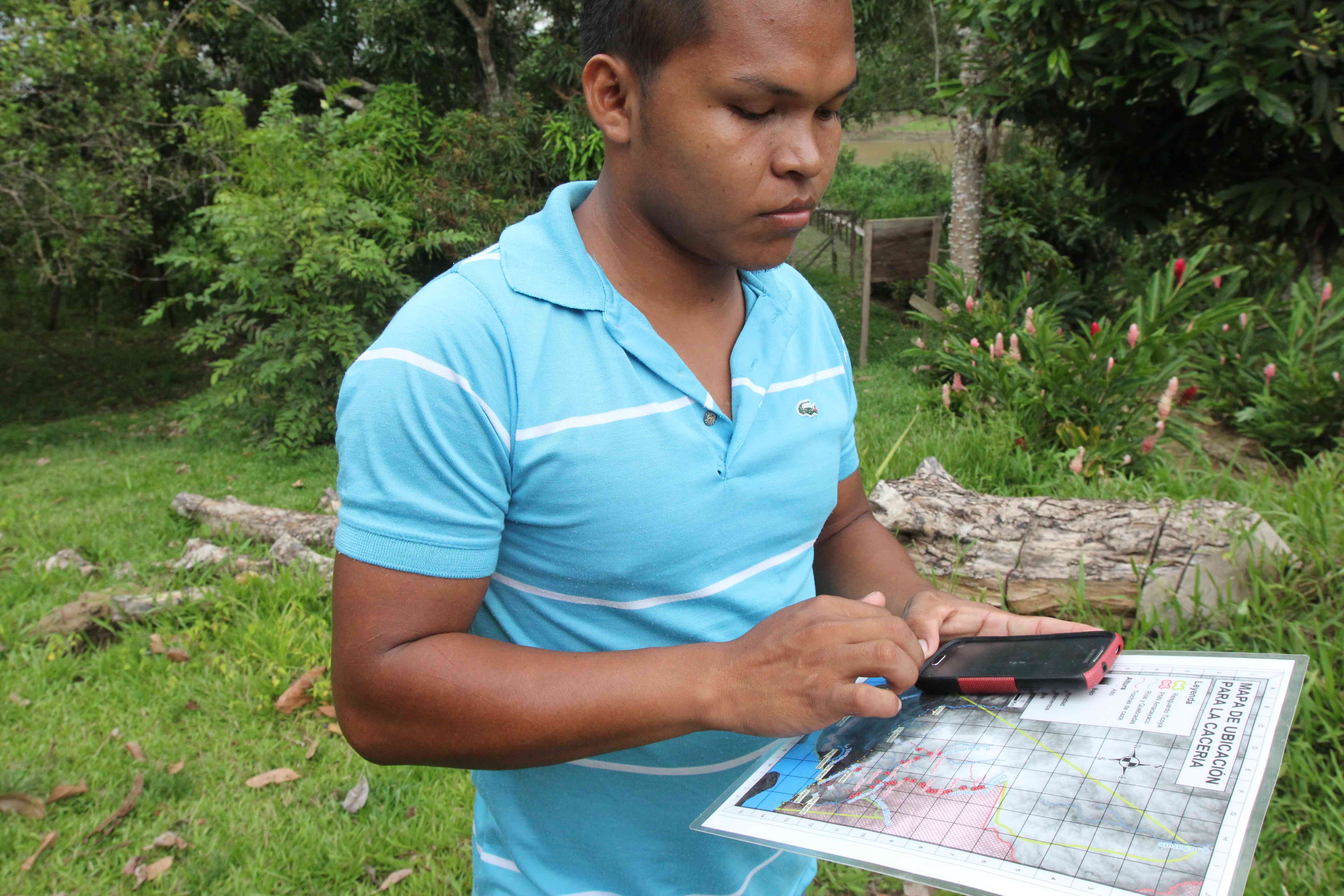Auri Almeida was selling fresh meat in the sunny plaza of the small Amazonian town of Puerto Nariño, Colombia, when a police officer approached, and her heart sank. The meat she was selling was from a tapir her husband had hunted the night before. The family had kept some, and she was selling the rest to cover her daughter’s school expenses.
While hunting for food is legal in Colombia, selling the meat is not, and the officer could fine her and confiscate the remaining meat. Instead, he gave her a tip – next time, keep the meat in a bag out of sight.
Despite the prohibition the market for wild game, or bushmeat, thrives in this corner of Amazonia, where the borders of Colombia, Brazil, and Peru converge along the Amazon River. Hunters, traders, vendors, and restaurants provide more than 470 tonnes of bushmeat a year to people who buy it for special occasions or just because they like it.
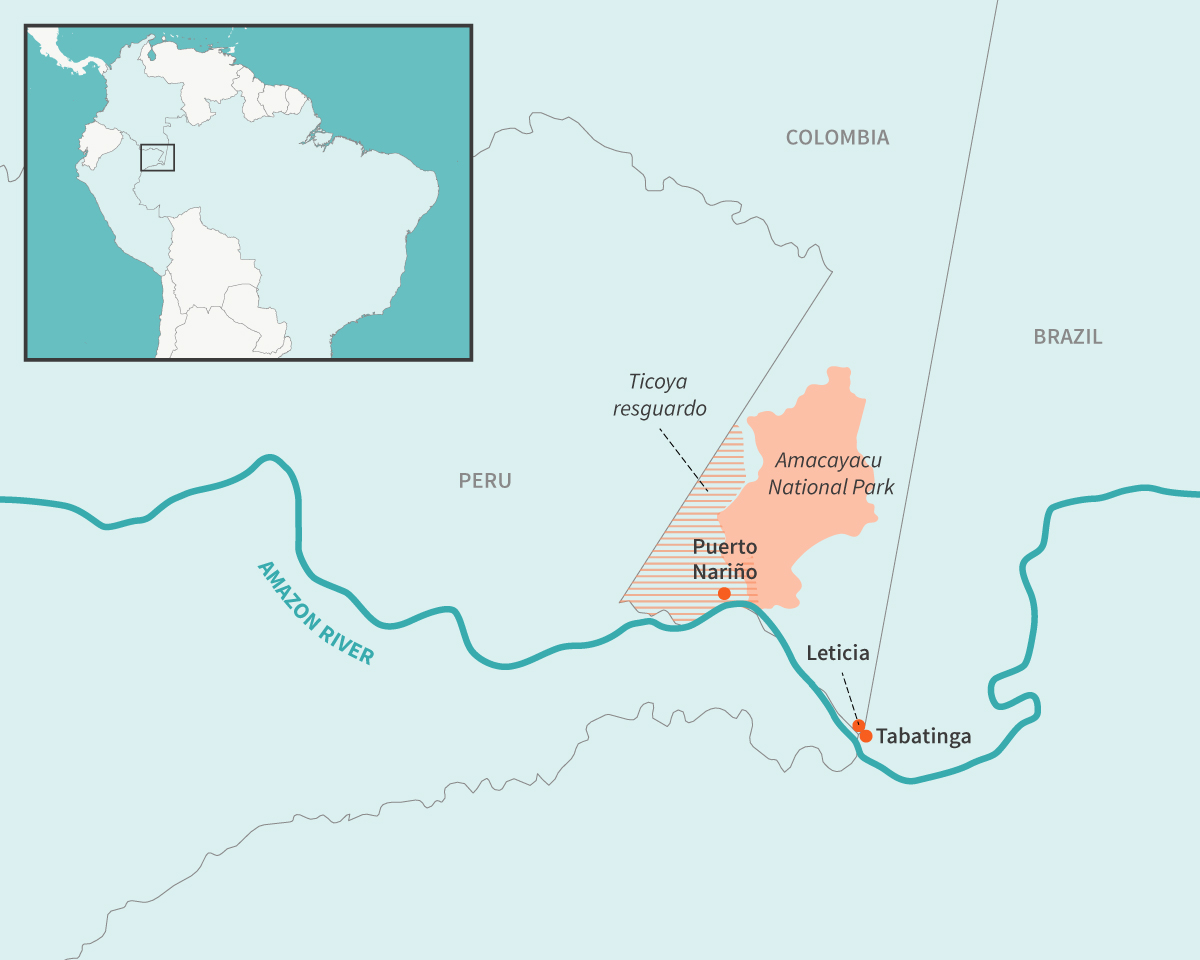
Hunters from villages nearby hunt in areas that abut the Ticoya resguardo, which adjoins Amacayacu National Park. Copyright: E. Wikander/Azote.
Ecologists worry that the trade is emptying forests of wildlife, with impacts that ripple through the ecosystem and ultimately threaten the diet of rural villagers. “Defaunation”, as biologists call it, changes not just animal populations, but also plant communities, by robbing forests of birds and animals that distribute seeds of certain species. This can further stress forests already under siege from more frequent droughts, as well as logging, deforestation for ranching and farming, fragmentation due to road construction, fires, and other human impacts.
“Bushmeat is an important source of protein for indigenous communities in rural areas”, says geographer Nathalie van Vliet of the Indonesia-based Center for International Forestry Research. The market chain is illegal, but because the market exists, Van Vliet thinks it’s necessary to discuss the potential for sustainable management of some of the species with populations that could withstand a certain level of hunting.
The debate over whether hunting wild game can be made sustainable – and if so, how and at what levels – affects rural dwellers in both Latin America and Africa, especially in the tropical forests in the Amazon and Congo basins. Van Vliet, who studies wildlife and livelihoods in both regions, has teamed up with hunters and vendors to explore policies and practices that would allow hunters to sell meat without depleting wildlife populations.
It’s a question that has intrigued her for the past several decades, since she was a 19-year-old research assistant at an Amazonian field station, where the researchers sat down to meals of pasta and tuna every day.
“I saw that the indigenous women helping in the kitchen ate other things, like fish”, Van Vliet recalls. “I asked them one day, and they were preparing peccary”, a piglike mammal.
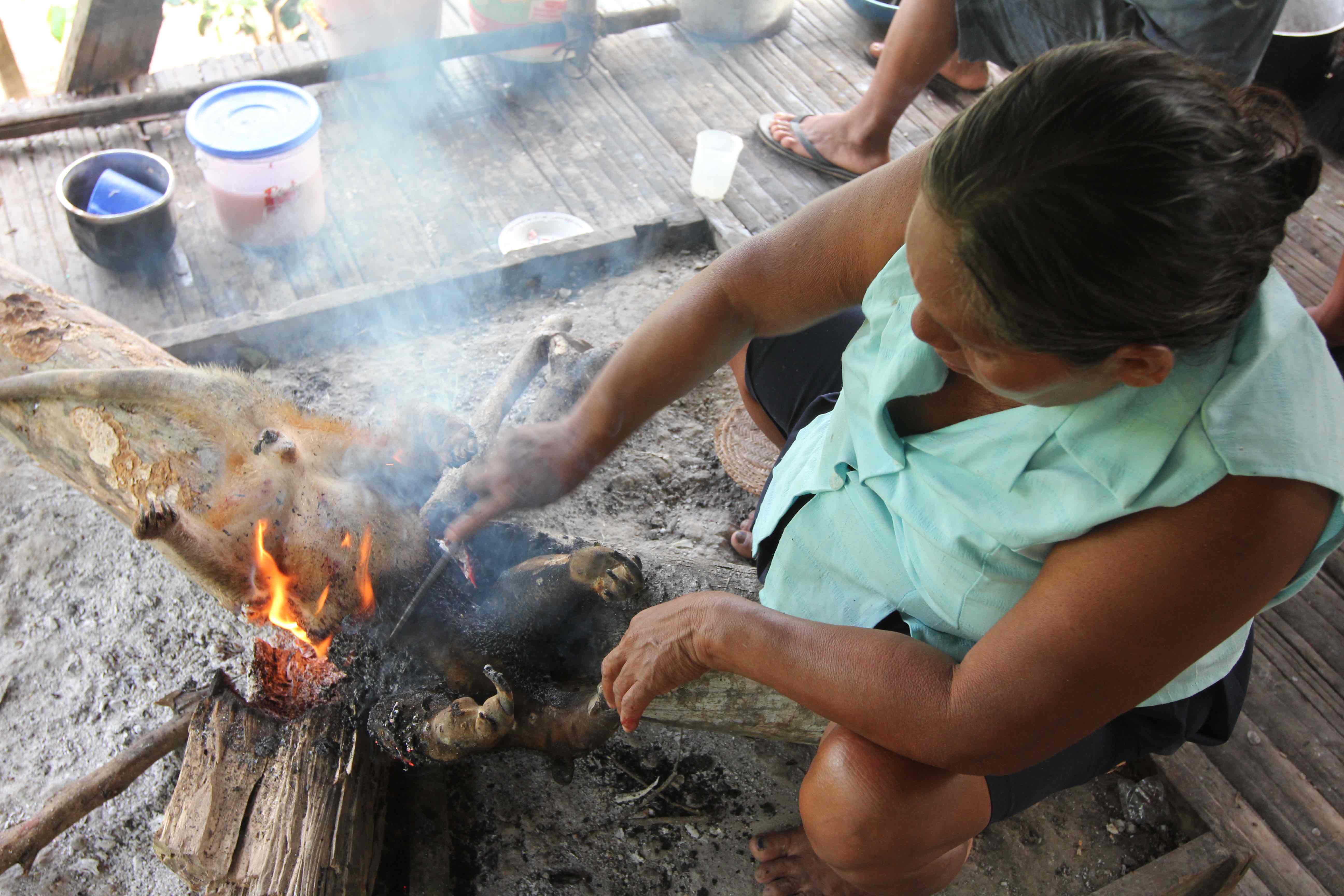
A woman prepares an anteater for supper from the day’s catch. Copyright: Barbara Fraser.
While she and her colleagues were studying biodiversity and potential threats to it, there was little information about how people who lived in the forest used the resources they found there, including the meat of the animals the scientists were investigating, or how those products circulated in local markets, she says.
Amazonian riversides are dotted with tiny villages of thatch-roofed houses built of wooden planks or poles and raised on stilts to withstand seasonal flooding. Far from supermarkets, villagers depend on the crops they grow, such as cassava and corn, and on the fish they catch and the animals and birds they hunt.
Wild game is not a huge percentage of the diet – in a 2013 survey Van Vliet conducted in the area where the borders of Brazil, Colombia, and Peru converge, about 11% of school children in rural villages reported having eaten bushmeat the previous day – but it provides a steady supply of protein and fats and different micronutrients.1 1. Van Vliet, N., Quiceno-Mesa, M. P., Cruz-Antia, D., Tellez, L., Martins, C., Haiden, E., Ribeiro Oliveira, M., Adams, C., Morsello, C., Valencia, L., Bonilla, T., Yagüe, B., Nasi, R., 2015. “From fish and bushmeat to chicken nuggets: the nutrition transition in a continuum from rural to urban settings in the Tri frontier Amazon region.” Ethnobiology and Conservation, 4:article 70. DOI: 10.15451/ec2015-7-4.6-1-12 See all references
Amazonian residents consume about 1 million tonnes of wild game meat a year. That is just one-third of the amount consumed in Africa’s Congo Basin, however, according to recent estimates by Van Vliet and colleagues. In both regions, bushmeat consumption is lower in rural areas than in cities, although the true extent of the markets could be concealed by a lack of data.2 2. Nasi, R., Van Vliet, N., 2011. “Empty forests, empty stomachs? Bushmeat and livelihoods in the Congo and Amazon Basins.” International Forestry Review 13(3):355-368. DOI: 10.1505/146554811798293872. Download PDF See all references
Researchers have documented several hundred hunted species in Latin America. In Africa, they have found more than 100 hunted just in Gabon. In both regions, the most frequently hunted species are rodents and ungulates, particularly small deer or antelope. Hunting has drastically reduced populations of some larger species, such as woolly monkeys and spider monkeys in Amazonia. Animal population densities tend to be lower in areas used by hunters.
Although the decrease in game animal populations is noticeable, especially as high-tech hunting methods such as shotguns and cable snares replace traditional bow hunting or net snares, population data for many species are scant. This makes it difficult to judge the impact of hunting and devise effective management plans.3 3. Milner-Gulland, E. J., Bennett, E.L., the SCB 2002 Annual Meeting Wild Meat Group, 2003. “Wild meat: the bigger picture.” Trends in Ecology & Evolution. 18(7):351–357. ∗This article is jointly authored by Kate Abernethy, Mohamed Bakarr, Elizabeth Bennett, Richard Bodmer, Justin Brashares, Guy Cowlishaw, Paul Elkan, Heather Eves, John Fa, E.J. Milner-Gulland, Carlos Peres, Callum Roberts, John Robinson, Marcus Rowcliffe and David Wilkie. It resulted from discussions linked to two symposia at the 2002 Annual Meeting of the Society for Conservation Biology (SCB), co-hosted by the Durrell Institute of Conservation Ecology and the British Ecological Society. The SCB 2002 Annual Meeting Wild Meat Group is an informal group of some of the speakers who took part in this meeting, and is not linked to the SCB or any other organization. DOI: 10.1016/S0169-5347(03)00123-X See all references
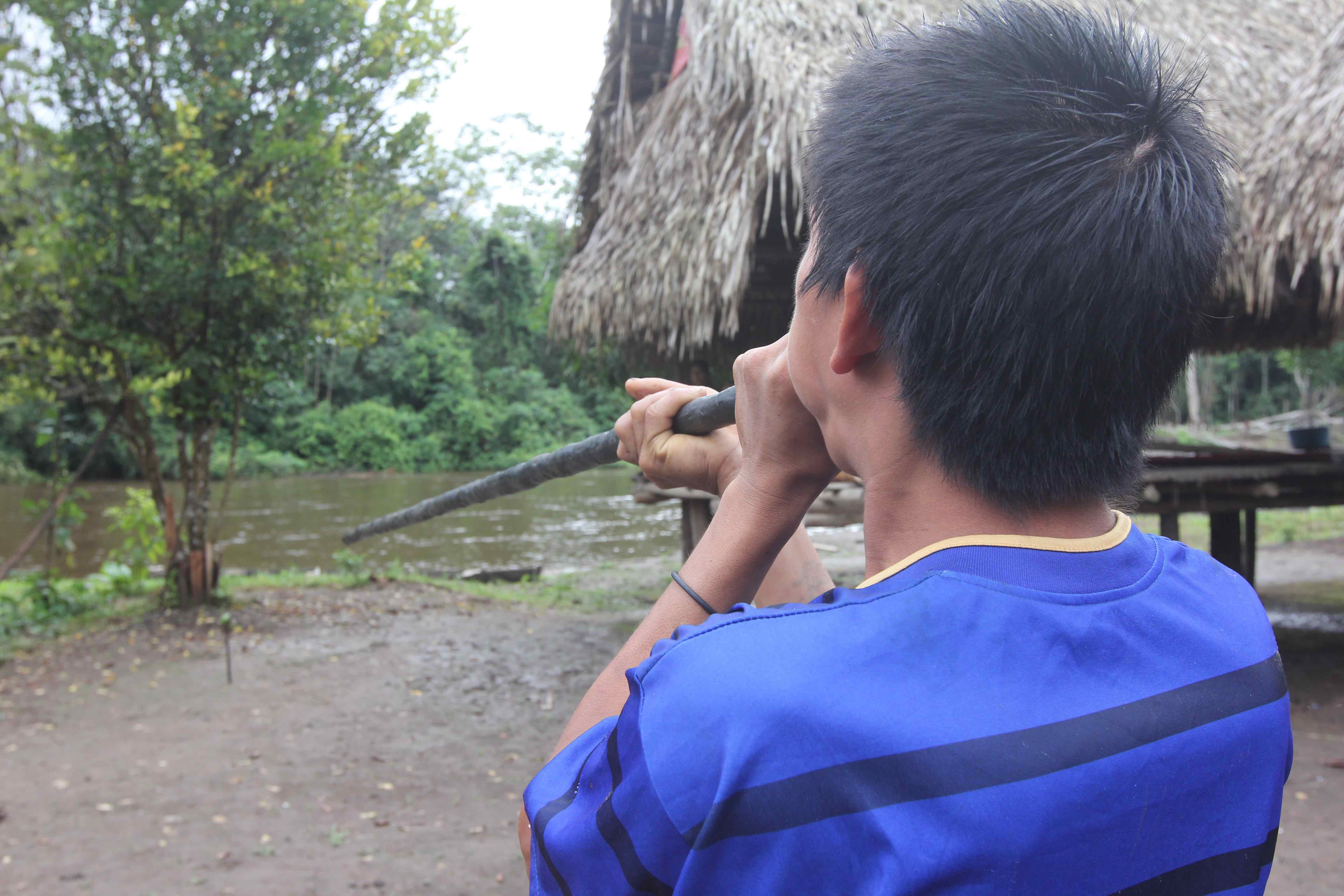
Bushmeat hunters are shifting from traditional hunting techniques, like this blowgun, to more modern ones, such as shotguns and cable snares. Copyright: Barbara Fraser.
The human relationship with wild game is sometimes an uneasy one, beyond issues of biodiversity and species protection. Wild game animals may carry pathogens that can spread to humans. At least 60% of human diseases are zoonotic, meaning they can be transferred between animals and humans, according to the World Health Organization.4 4. Jones, K. E., Patel, N. G., Levy, M. A., Storeygard, A., Balk, D., Gittleman, J. L., Daszak, P., 2008. “Global trends in emerging infectious diseases.” Nature 451:990-993. DOI: 10.1038/nature06536 See all references
Some disease outbreaks have been traced to African game animals – HIV in gorillas and Ebola in bats are notable examples. Primates can transmit other diseases to humans as well, such as monkeypox, Marburg virus, and Lassa virus. But not all disease outbreaks can be traced to wild game, and the fear of zoonotic diseases can sometimes cause other problems. In Brazil, a recent yellow fever outbreak in the Atlantic coastal forest killed both humans and monkeys. Even though yellow fever is actually transmitted by mosquitoes, just like malaria and dengue, locals were killing the monkeys, believing they were the source of the disease.
Although diseases can be transmitted when humans eat the meat of an infected animal, there are other pathways as well. People may come in contact with bacteria and parasites when gutting and cleaning the animals or preparing the meat.5 5. van Vliet, N., Moreno, J., Gomez, J., Wen Zhou, J., Fa, E., Golden, C., Alves, R. R. N., Nasi, R., 2017. "Bushmeat and human health: Assessing the evidence in tropical and sub-tropical forests." Ethnobiology and Conservation 6:article 112. DOI: 10.15451/ec2017-04-6.3-1-45 See all references Transmission routes can be complex and sometimes are unknown.
In cities, chicken trumps agouti
In the Amazon basin, the need for cash increasingly drives villagers to seek work in nearby towns or cities, and with that lifestyle change comes a change of diet.
Puerto Nariño is a town of about 7,000 people just a short hop by boat from the village where Almeida’s family lives in the Tikuna, Cocama, and Yagua (Ticoya) resguardo, an indigenous territory not far from the three-country border. Although it is a fairly small town, the difference between urban and rural diets is apparent. School children in Puerto Nariño reported eating less wild game meat and fish than their peers in outlying villages. And nearly half the kids surveyed in the town had eaten chicken or eggs the previous day, compared to only about one-third of the rural children.6 6. Sarti, F. M., Adams, C., Morsello, C., Van Vliet, N., Schor, T., Yagüe, B., Tellez, L., Quiceno-Mesa, M., Cruz, D., 2015. "Beyond protein intake: bushmeat as source of micronutrients in the Amazon." Ecology and Society 20(4):22. DOI: 10.5751/ES-07934-200422 See all references
The difference is even greater downriver, where the larger towns of Leticia (Colombia) and Tabatinga (Brazil) sit side by side on the banks of the Amazon.
On the outskirts of Leticia, less than 30% of children reported having eaten fish or game the day before, a figure that dropped to just over 10% in town. In both areas, at least half the children reported having eaten chicken or eggs, but one of the food categories that increased most was processed meats.
That change in diet raises red flags for Van Vliet. Hot dogs and tinned meats are high in fat and salt, which contribute to chronic health problems such as heart disease and hypertension. And switching to chicken as the main source of protein reduces some micronutrients in the diet. A study in five towns and three peripheral urban areas on the border of Colombia and Brazil found that protein, iron, and zinc consumption was lower among families that consumed chicken rather than bushmeat.6 6. Sarti, F. M., Adams, C., Morsello, C., Van Vliet, N., Schor, T., Yagüe, B., Tellez, L., Quiceno-Mesa, M., Cruz, D., 2015. "Beyond protein intake: bushmeat as source of micronutrients in the Amazon." Ecology and Society 20(4):22. DOI: 10.5751/ES-07934-200422 See all references
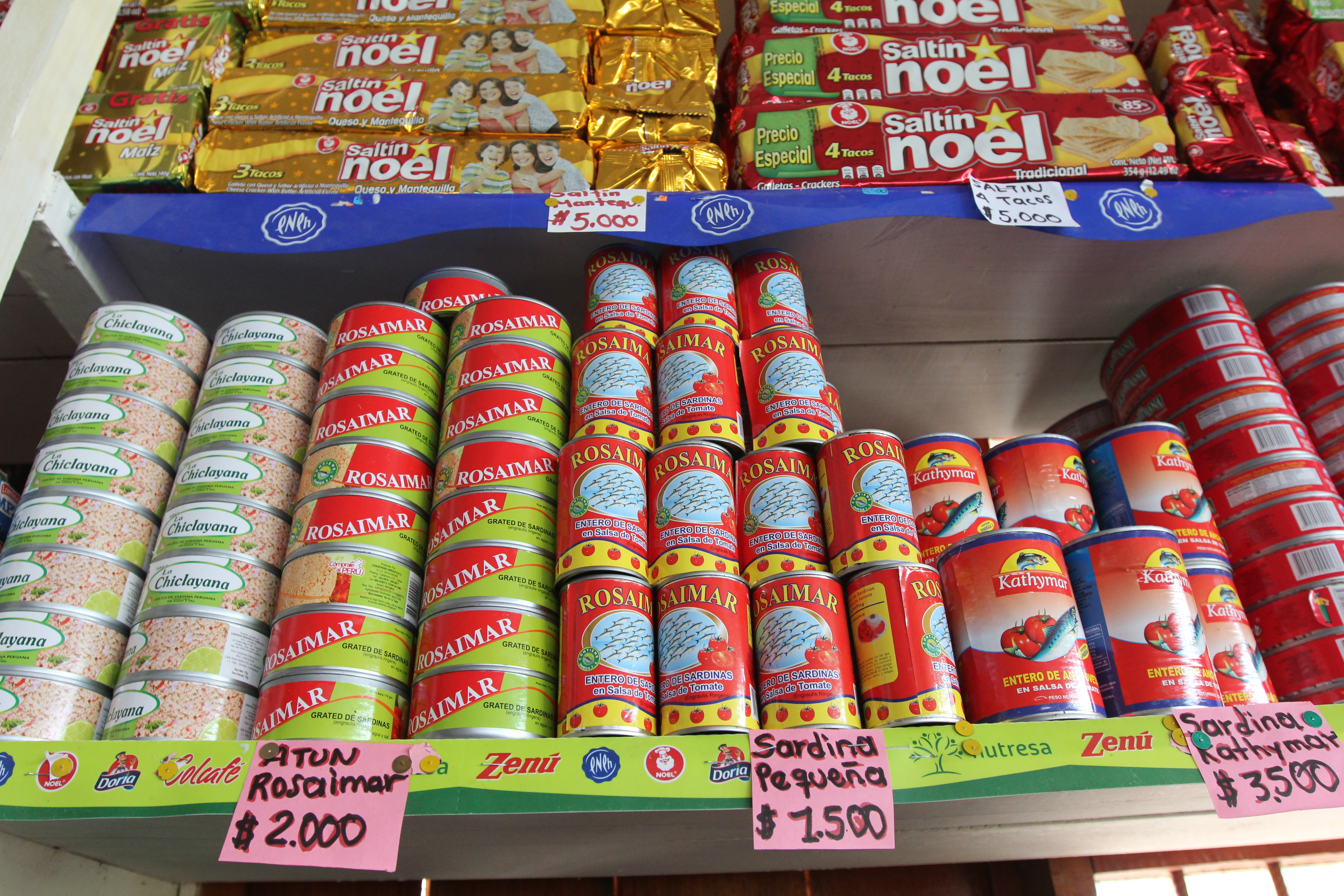
When people move from rural villages to towns, they tend to eat less bushmeat and more tinned meats and fish. Photo: Barbara Fraser/CIFOR.
The poultry that makes up a larger part of the urban diet also has an ecological cost. Most of the chickens sold in Leticia are flown in from industrial farms in southern Brazil. So besides the environmental and health issues associated with factory farming, such as nutrient run-off and antibiotic use, air transport gives them a large carbon footprint, Van Vliet notes.
Replacing wild meat with beef also has a cost, as cattle ranching, along with commodity crops such as sugar cane and soya, is responsible for increasing deforestation rates in the Amazon and contributes to climate change. “We tend to take for granted that we need to reduce bushmeat use and replace it with agricultural production”, she says. “We are forgetting that there are huge trade-offs between the two options. What about the ecological impact of industrial agriculture?”
Bringing wild game out of the shadows
People who move to town tend to keep one foot in the forest, seeking bushmeat for festivals or when they are nostalgic for the tastes of home. Because the sale is illegal, however, a shopper can’t just go to the market and ask for wild game meat – and neither can a researcher.
To study the clandestine trade, Van Vliet and her colleagues first had to find it.
“We spend a lot of time being there, looking at what’s going on, eating at the market and asking questions until people trust us”, she says. “We never have in the back of our minds that they are doing something illegal. They are just doing their job.”
Once she and her colleagues won the vendors’ trust, they found themselves inside a world that most researchers have never seen, where vendors sell fish – particularly the highly prized giant pirarucú or paiche (Arapaiama gigas) and gamitana (Colossoma macropomum) – openly in their market stalls and keep bushmeat out of sight in a freezer.
They buy directly from hunters or from intermediaries, and they use cell phones to take orders and arrange for customer pick-up.
Although that reduces the risk of being caught, police sometimes raid their stalls, confiscating the meat or asking for bribes. And the same people who enforce the law sometimes buy meat, says one seller in Leticia.
The seller is one of a handful of vendors who have helped with Van Vliet’s study, keeping meticulous records of the amount and type of meat they buy and sell, how much they pay, and their profit.
Based on these studies, the researchers calculate that about 473 tonnes of wild game meat pass through the markets in the towns near the triple border each year.7 7. Van Vliet, N., Quiceno-Mesa, M. P., Cruz-Antia, D., de Aquino, L. J. N., Moreno, J., Nasi, R., 2014. "The uncovered volumes of bushmeat commercialized in the Amazonian trifrontier between Colombia, Peru & Brazil." Ethnobiology and Conservation 3(7):11p. DOI: 10.15451/ec2014-11-3.7-1-11 See all references
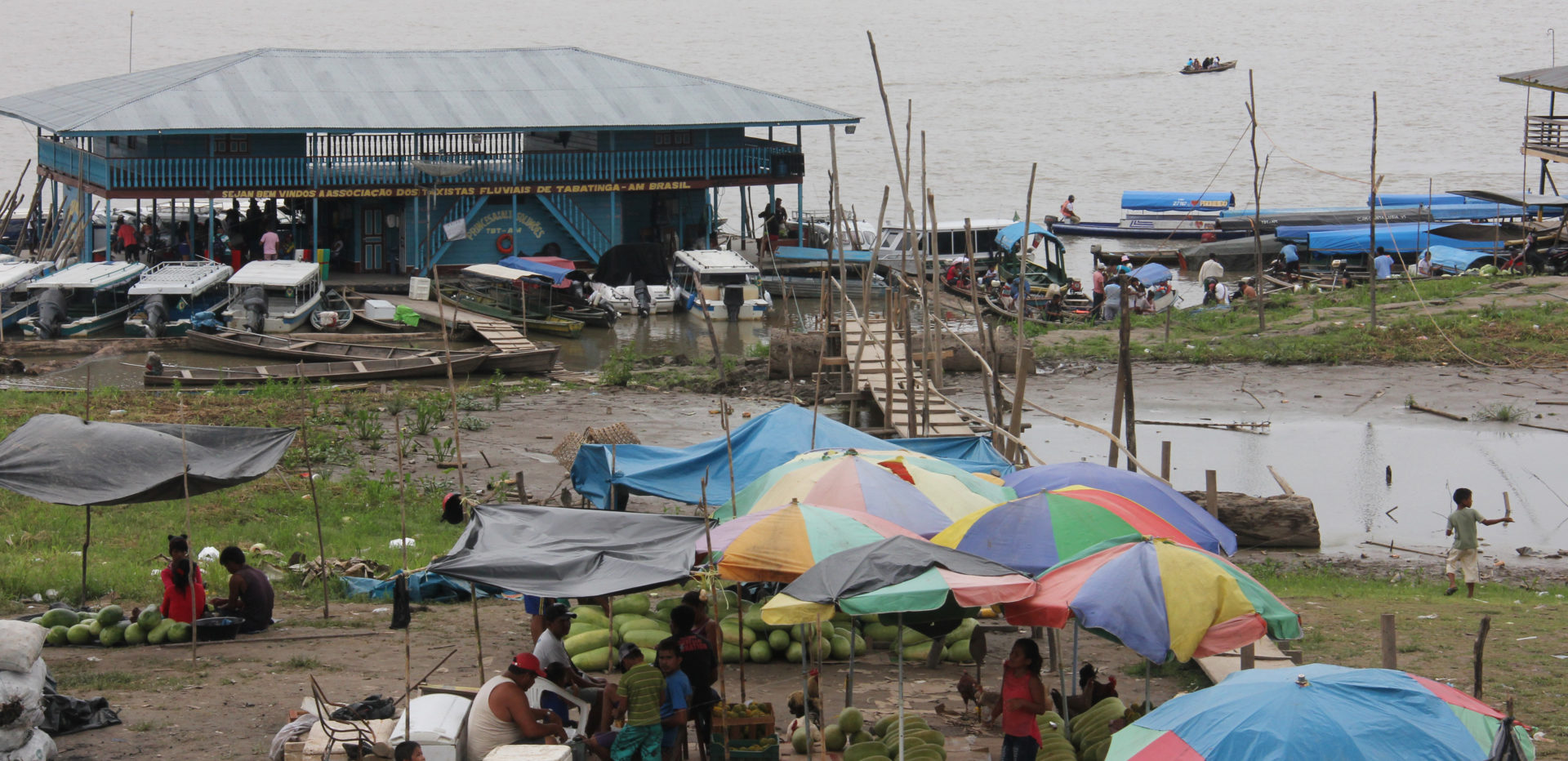
 19 MIN READ / 3032 WORDS
19 MIN READ / 3032 WORDS
